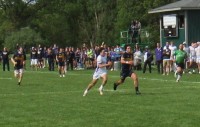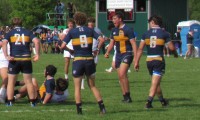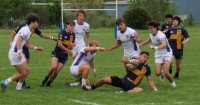Analysis: How St. Ignatius Got to the Top
Analysis: How St. Ignatius Got to the Top
(Analysis Column by Alex Goff)—It is a rare thing that I as a journalist get a front-row seat to a championship team throughout the season.
For the most part, I can sometimes see a team play a few times during the year, and maybe feel like I've got a handle on how they do things, but seeing them do what they do every day? The stars have to align. In fact, probably the last time that really happened was 2001, when I was an assistant coach with the HS team that became the Budd Bay Barbarians. Playing as Capital HS, this team finished a very creditable 5th at the HS National Championships, and I got to see exactly how they got there.
This year was interesting because I was able to observe St. Ignatius several times a week, but with a slight separation. As many of you know, I assist with the St. Ignatius freshman team. I don't do any coaching with the varsity program, but I can see what they do and I generally attended practice about three days a week. Oddly, I didn't see them play a lot—I was usually traveling somewhere else. But I did get to see film and had several interesting talks with the coaching staff and the players.
So this spring was certainly an interesting journey watching a high school team that had a very specific goal to win the national championship, and how they went about it. Here are some observations:
Out of Nowhere
St. Ignatius did not come out of nowhere. They have been good for several years, and in some years GRR ranked them #1 at times. But they didn't go to the National Championships because it conflicted with key events on the school calendar. From 2015 through 2020 Ignatius ended the season in the GRR Top 10 four times. Their lowest end-of-year ranking was #14. So, no, this isn't a case of a team rising to prominence thanks to a unique group of players.
In 2021, however, despite a shellacking at the hands of the Charlotte Tigers in their opening game, St. Ignatius, is became clear, was a really strong outfit. When HS Nationals returned, and was set for June, and some spots opened up because some teams couldn't travel, the Wildcats put their hat in the ring. It was a new experience for the program, and they learned quickly that a) even a low-seeded team can cause you fits, b) when you play at Nationals there is pressure, and c) they are pretty good.
In faction, St. Ignatius losing that 2021 final to Herriman may have done more for their reputation around the game than if they had won. Winning in your first appearance at Nationals is so rare that many might have written it off as a once-in-a-lifetime season. Coming in a very competitive second, however, made everyone pay attention.
There Were Some Special Elements
The key special element to the 2021-2022 run for Ignatius was that most of their starting lineup from 2021 were juniors. They would return for 2022, and would have seen all of the pitfalls of a big season. That group also returned with a singular goal to win the championship. How they approached that we'll discuss below. Certainly they all knew the standard they needed to achieve, and also that they could achieve it.
Understanding that standard was voiced by Head Coach Dan Arbeznik way back in March of 2021 when they lost 47-0 to the Charlotte Tigers. As both teams circled up together, Arbeznik said that one of the core Jesuit values was humility. We have certainly been humbled today, he said without a hint of animosity. We will learn from that.
And they did, looking for tough games throughout the season, making some significant changes, and asking more of themselves. There was no whining about how the Tigers were this massive club of massive players—it was all about resetting goals.
Chasing the Goals
So from the beginning St. Ignatius approached their season with these thoughts in mind:
- Winning Nationals will take as many as 40 players, with a quarterfinal lineup that has to perform, and has to allow other players time to be fresh for following games
- That squad of 40 essentially would then expand to everyone—the entire program has to be behind the effort
- Winning Nationals will require going above and beyond in terms of physical and mental preparation
- The game plan had to be rock-solid, and players had to put the plan and the team above their own whims
How this manifested itself was in several areas. The attitude among players for who would start and who would be on the bench, or not playing at all, was, in my observation, one of the main reasons St. Ignatius won the National Championship. When it was one player's turn to start, he was supported and helped. What this did was allow players to step in for the injured, or just the tired, knowing his teammates had his back.
Players added extra running and other fitness work outside of practice. As Arbeznik told them, he wouldn't be enforcing this extra work—they had to do it on their own. "You need to want it more than I do," he said. The motivation to work hard had to come from within, and from teammates. Great athletes often say they never had to be told to practice, and day after day, after rugby practice was done, and if there was space, the Ignatius varsity players ran sprints.
And there were changes in how players viewed themselves. Some took on very unglamorous roles because that's what was needed. Flyhalf Bobby Voth, who was a good kicking flyhalf who sent this lovely, soaring kicks in 2021, started to drive uglier-looking kicks down the field. Why? Because they were more effective. The result was several successful 50-22s for Ignatius, and, in the final, Gonzaga was guarding that tactic so assiduously that Ignatius was able to make ground on the edge.
The Setup
St. Ignatius is a private Jesuit school in Cleveland. It is set in a neighborhood that used to be gentrified, hit hard times, and is working back to a kind of hipster cool aspect. Around the corner from the school is the birthplace of John Heisman of Heisman Trophy fame. The school has some enviable facilities, including a really nice gym with an elevated running track, an indoor turf facility used during winter weather by the baseball team, the lacrosse team, and the rugby team.
It has a turf football stadium (although anyone from Texas or Eastern Pennsylvania would not call it a stadium as it seats maybe 100 people) where the rugby team plays its home games. And it has to turf fields, end-to-end, where the rugby team practices. But that sounds quite fancy, and in many ways it is. However, there are often days where those two fields are also shared by the lacrosse and baseball teams. What you might think are 200 meters of space could easily drop to half that, and with over 130 rugby players in the program, space becomes a bit limited.
The space limitations are addressed through efficiency. Arbeznik and his staff set up a system that allows for the first 15 to 30 minutes, or more, of practice to be player-run. While there are as many as 14 coaches involved, if every one showed up 30 minutes late, the players could effectively start without them.
The simplest form of this play-driven start to training is just to call out a few simple words for them all to organize into passing, support, and contact workouts. But it can be more complex as all the players mix in some contact and breakdown work that is mentored by the senior players. You might have a group of six players, with two freshmen, a sophomore, two juniors, and a senior running the drill. It forces senior players to give a hand up and include younger players into the program, and it also forces senior players to know what they are talking about when they discuss how to set a ruck or poach a ball.
And in the most complex form the program is split into tribes. The tribes have players from all four years, and they compete through various rugby activities for points and some bragging rights at the end of the season. Some practices have a lot of tribe work, and the players are now holding each other to a standard, because the tribe standings are at stake. It creates a team bonding across age groups while also using competition to get better.
Coaching
Head Coach Dan Arbeznik played rugby for a short time. Injuries curtailed his career, but he's a smart, analytical coach who also coached with the St. Ignatius football program. He teaches Latin at the school and runs the program. It's his vision on how things are done. He is tracking the progress of players (he can wax knowledgeably about ny player in the program and how that player is developing), coaching down to the details, and runs pretty much all of the team's admin.
But he also delegates, and how he delegates is crucial. Any coach with something to add is welcomed. The input from Tim Brofman in the scrum and Owen Hundt in the maul and lineout is an example. AJ Short's conditioning plans and Hanno Van Vuuren's video analysis or the tactical and skills input from Nick DiPietro, Joe Zawodny, Brian White, Connor Fitzpatrick, and more all are taken on board. It's interesting to note that the founder of the program, Tony Vegh, remains with St. Ignatius as the Head Coach of the freshmen—not every coaching group could handle that balance of egos, but at Ignatius the camaraderie within the staff is unmistakable.
The tone is quiet, analytical. The coaches get along (and that's obvious to the players), and head guy is generally very sanguine. What this creates is an environment where players are not afraid to make mistakes.
There Has To Be a Speed Bump
Every chase to a national championship has to encounter a challenge. If it's too easy, then a team might not survive the tough games at the end. This year, the speed bump for St. Ignatius came in France. The Wildcats won their first two games on the tour, and while those games were educational and close, they still just built on the team's confidence. Then came Rouen Academy. Playing against a team of hope-to-be professionals, they lost big. They didn't have an answer for the pace of Rouen's game. Instead of coming home from their tour feeling on top of the world, they were shaking their heads. We have a long way to go, they said.
That was crucial, really. Ignatius put a stranglehold on the opponents after that.
It's a Team Sport
On May 20 St. Ignatius rugby player Marty Lenehan was named the schools Athlete of the Year for his play as a rugby and football player. Lenehan was outstanding playing as an inside center who also jumped in the lineout and as a running back for the football team. And yet, we didn't see much of Lenehan at National Championships because he was injured. He has dislocated his shoulder shortly before the tournament, and while he did take the field, he was handled with kid gloves. But St. Ignatius won it all anyway.
They did that because not only do they play as solid team game, the attitude, borne out of how they train and prepare meant that no players or coaches were panicking about Lenehan not being available. Tim Putka put on the #12 jersey and was arguably the player of the final.
More Coaching-Tactics and Strategy
In 2021 the heat in Kansas City forced HS nationals organizers to allow for subs to be taken off and brought back on (still limited to eight on the bench) in order to guard against heatstroke. Really only one Head Coach embraced that rule to the fullest and that was Arbeznik. He set forth a substitution plan that ultimately brought impact players onto the field in the middle of the game.
This year, once again Arbeznik used his bench as a weapon, not as a last report. This included putting some players on as subs 20 minutes into the game. The idea there was to bring that inject of energy while the game was still in the balance. It had an unintended positive effect in the final. Ian Milosovic started at lock with the plan being to bring in the powerful and emotionally positive Sean Ward at 20 minutes. As it turned out, Milosovic suffered a suspected concussion early in the game, but because of the substitution plan, Ward was already warming up and ready to go.
As for the final itself, the plan was to kick with the wind and not kick when against the wind. But of course it's not that simple. If you kick, you need all of your chasers dialed in and your forwards not to go offside. In the first half with the wind, Voth's kicks were smart—hitting grass or being difficult to catch—and the backs chased and made open-field tackles to prevent counter-attacks. The forwards, meanwhile, committed no offside penalties; thus everyone on the team was aware of how they would exert territorial pressure on Gonzaga.
In the second half, there was no kicking. Voth can be described as a kicking flyhalf, but he did none of that, and retained the discipline to use his runners to get out of their 22. Both Tim and Ryan Putka, Jack Dulik, John Reddy, and Pat Clink made key runs to force Gonzaga backward. And at the same time, any team has to be worried about a runner getting isolated and penalized for holding on. The work rate of Ignatius in getting clearouts taken care of at the ruck was nothing short of excellent. All of that was due to discipline and buy-in to the plan.
RUG: Within a minute of Georges’ try, Nate Polinko fights his way in for a try! The Wildcats lead Gonzaga (DC) 14-0 in the National Championship! #GoCats pic.twitter.com/x7oI5GidNs
— SIHS Sports (@SIHSSports) May 21, 2022
Everyone Has a Plan Until ...
Through the weekend I informed observers that there were some things you could take to the bank with St. Ignatius: their scrum was excellent, their maul was very difficult to stop, and when they got within five meters of the tryline, they scored. None of this turned out to be true in the final. Gonzaga's forwards played a superb game. Their goalline defense was close to perfect, they caused Ignatius all kinds of problem in the scrum, and prevented any tried from the maul. But Ignatius won anyway. How could that be? they didn't let those issues leak into their commitment to defense; they worked hard in support, and, as I said above, ran the kicking game well.
The ability to flush problems and keep playing can be seen in how they gave up their first try, and then Reddy skies up a full 11 inches to catch the restart and set up an attack that leads to a penalty to make it 20-7. It can also be shown in the work of Nate DesRosiers. The substitute hooker had to come on soon after starter Nate Polinko scored the second Ignatius try. Polinko's leg was hurt and DesRosiers was called upon. Unfortunately, after that, the links in the lineouts didn't quite come together. Gonzaga's tall forwards stole a couple of throws, and then a compensating higher throw went over the top. That's when Gonzaga scrumhalf Joey Ries nabbed the ball and scored his side's second try.
DesRosiers would be forgiven for imploding right then, but he didn't. Part of that was because his teammates immediately flooded him with encouragement. And then ... the moment. As Coach Brofman often said to the forwards, sometimes it only takes one scrum. One scrum at a critical moment. Up 20-14 with Gonzaga putting the ball into the scrum inside the Ignatius 22, the Wildcat pack put on a shove as DesRosiers stretched his leg out and stole the put-in. It was a momentum-shifter. Ignatius charged up the field from there and eventually got a penalty that Voth put over. Had Gonzaga scored, they would likely have converted to take a 21-20 lead. Instead, Ignatius was up 23-14 and basically had the game in hand.
In Victory
After the final both teams huddled up to congratulate each other for a game well played. But what I noticed (and tried to film only my camera decided to go out-of-focus) was when Ignatius was celebrating. All the players converged, and then scrumhalf Sean Lipaj looked over his shoulder and saw three or four Gonzaga players on the ground, distraught. They had, after all, put everything into that game. Lipaj peeled away from his teammates and instead went over to console his opponents. He was joined by another teammate soon thereafter.
Is that the mark of a champion? Yes, it is. That doesn't mean it always happens when there's a champion. But for me it's a microcosm of what I observed for the past six months. A group that put team, and yes, sportsmanship, above individual. A group that embraced the job ahead, even when it wasn't glamorous. A bunch of kids from Cleveland (and on import ... from California!) may not be the most athletic rugby players in the country, but the results show what I saw all spring—the best rugby team in the country, without a doubt.
















